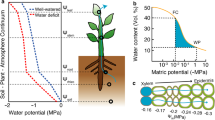Abstract.
In the semi-desert environment of the Mu Us Sandland, the vegetation is composed chiefly of shrubs and semi-shrubs, coverage normally amounting to 30–40%. However, an exception can be found in the community of Sabina vulgaris Antoine, an evergreen shrub, which tends to grow so densely that it covers the sand dunes completely. Previous research has indicated that the high density of Sabina is parallelled by the very low transpiration rate. Based on anatomical and scanning electronic microscopic observations, this paper also points out that two structural features should play an important role in the potential mechanism of water conservation in this plant. First, a low stomatal density in S. vulgaris can lead to a high stomatal resistance and low transpiration. Second, the morphological feature of S. vulgaris leaves being tightly pressed to the stems might be a structural feature of water conservation, because in this way the leaf side bearing more (and mostly larger) stomatal pores could be protected from direct high radiation, while the side with fewer (and mostly smaller) pores (the outer side) is exposed to the dry desert air.
Similar content being viewed by others
Author information
Authors and Affiliations
Additional information
Electronic Publication
Rights and permissions
About this article
Cite this article
Dong, X., Zhang, X. Special stomatal distribution in Sabina vulgaris in relation to its survival in a desert environment. Trees 14, 369–375 (2000). https://doi.org/10.1007/s004680000054
Received:
Accepted:
Published:
Issue Date:
DOI: https://doi.org/10.1007/s004680000054




